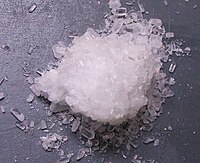
Photo from wikipedia
PurposeHematopoietic cell transplant (HCT) recipients often require intravenous (IV) magnesium repletion due to poor dietary intake, gastrointestinal loss, and use of concomitant magnesium wasting medications. Prolonging the IV magnesium infusion… Click to show full abstract
PurposeHematopoietic cell transplant (HCT) recipients often require intravenous (IV) magnesium repletion due to poor dietary intake, gastrointestinal loss, and use of concomitant magnesium wasting medications. Prolonging the IV magnesium infusion rate has been postulated to reduce renal clearance and improve retention; however, limited evidence supports this hypothesis.MethodsWe reviewed autologous and allogeneic HCT recipients (n = 82) who received IV magnesium at our institution between 2014 and 2016: 41 patients received IV magnesium at a prolonged rate of 0.5 g/h and 41 patients at > 0.5 g/h (mean 2.07 g/h). Primary outcome was percent of days in which magnesium levels were in desired therapeutic range (2–2.7 mg/dL) during hospitalization.ResultsBaseline characteristics were similar between cohorts: no difference existed between groups in incidence of gastrointestinal graft-versus-host disease or the percentage of patients who received magnesium replacement in maintenance fluids, received concomitant oral magnesium supplementation, or received parenteral nutrition. Percent of days in desired therapeutic range was not different between groups (p = 0.3). No difference existed between groups with respect to total amount of IV magnesium repletion (22.5 vs. 21.4 g, p = 0.81) or number of days of IV replacement (7.2 vs. 6.2 days, p = 0.41). In terms of safety, there was no difference between groups with respect to incidence of hypomagnesemia or hypermagnesemia (p = 0.43 each).ConclusionsOverall, prolonging the infusion rate did not correlate with improved magnesium retention based on amount and frequency of magnesium repletion or attainment of goal levels in HCT patients.
Journal Title: Supportive Care in Cancer
Year Published: 2018
Link to full text (if available)
Share on Social Media: Sign Up to like & get
recommendations!